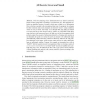Free Online Productivity Tools
i2Speak
i2Symbol
i2OCR
iTex2Img
iWeb2Print
iWeb2Shot
i2Type
iPdf2Split
iPdf2Merge
i2Bopomofo
i2Arabic
i2Style
i2Image
i2PDF
iLatex2Rtf
Sci2ools
ESOP
2009
Springer
2009
Springer
All Secrets Great and Small
Tools for analysing secure information flow are almost exclusively based on ideas going back to Denning’s work from the 70’s. This approach embodies an imperfect notion of security which turns a blind eye to information flows which are encoded in the termination behaviour of a program. In exchange for this weakness many more programs are deemed ”secure”, using conditions which are easy to check. Previously it was thought that such leaks are limited to at most one bit per run. Recent work by Askarov et al (ESORICS’08) offers some bad news and some good news: the bad news is that for programs which perform output, the amount of information leaked by a Denning style analysis is not bounded; the good news is that if secrets are chosen to be sufficiently large and sufficiently random then they cannot be effectively leaked at all. The problem addressed in this paper is that secrets cannot always be made sufficiently large or sufficiently random. Contrast, for example, an encr...
| Added | 19 May 2010 |
| Updated | 19 May 2010 |
| Type | Conference |
| Year | 2009 |
| Where | ESOP |
| Authors | Delphine Demange, David Sands |
Comments (0)

